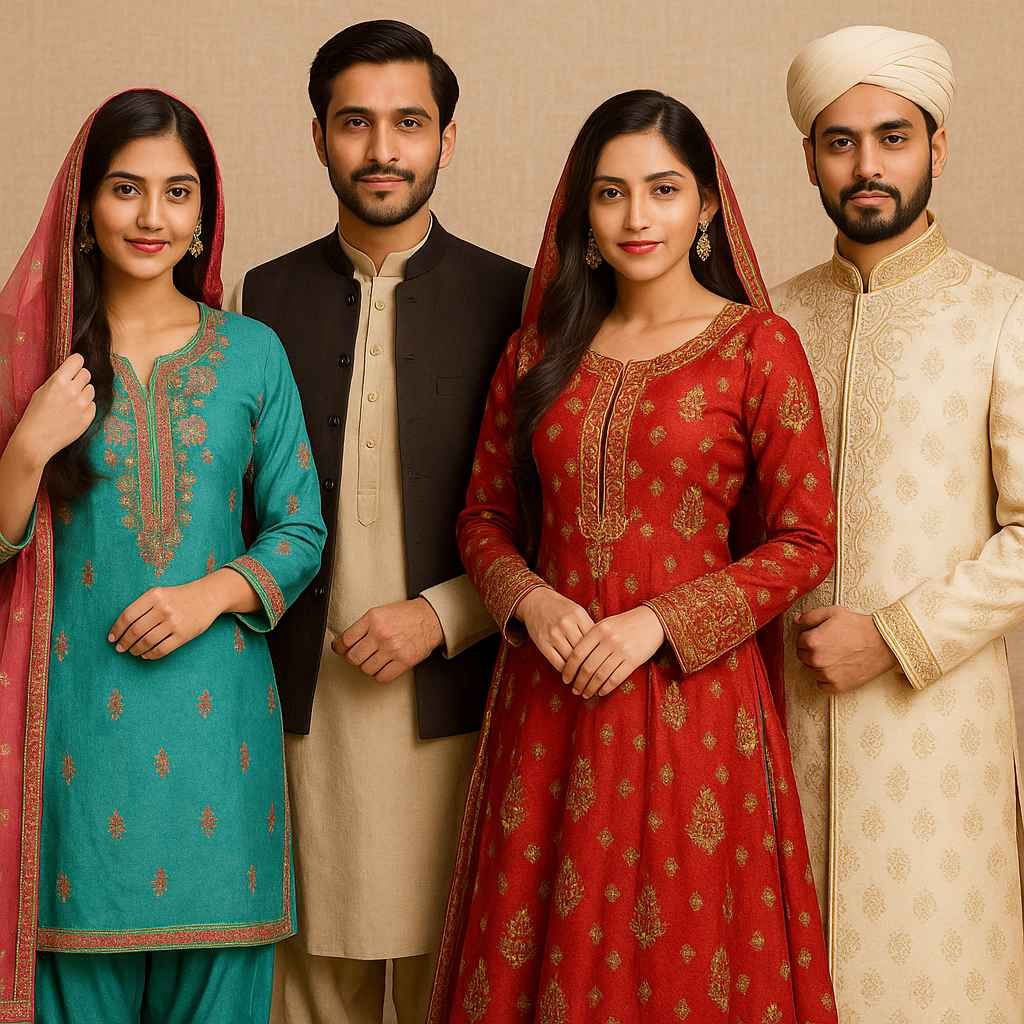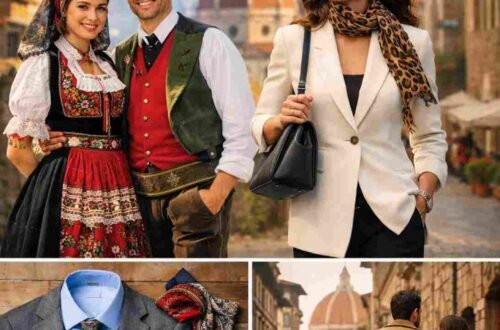Clothing in Pakistan shows its culture, traditions, and beauty. Every part of the country has its own style — colorful dresses from Punjab, mirror work from Sindh, or warm shawls from Kashmir. Pakistani clothes mix old traditions with modern fashion. The shalwar kameez is worn by everyone, and wedding outfits are famous for their embroidery and bright colors. These clothes are not just fabric — they tell stories of art, history, and identity.
History of Pakistani Clothing
| Time Period | What Happened | Influence on Clothing |
|---|---|---|
| Indus Valley (Ancient) | People made handwoven cotton fabric | Simple, natural-colored clothes |
| Mughal Era | Rich culture from Central Asia and Persia | Silk, embroidery, long gowns |
| British Period | Western styles came in | Pants, coats, and stitched designs |
| After Independence (1947–Now) | Pakistan became a new country | Shalwar kameez chosen as national dress |
Did you know? People in the Indus Valley were among the first to make cotton fabric in the world!
Main Types of Traditional Clothes
1. Shalwar Kameez (National Dress)
-
Worn by both men and women
-
Shalwar: loose pants
-
Kameez: long shirt or tunic
-
Comfortable for all weather
-
Simple for daily wear, fancy for parties or weddings
2. Dupatta, Chadar, and Shawls
-
Long scarf or wrap worn by women
-
Used for modesty and decoration
-
Types:
-
Ajrak from Sindh (block print)
-
Phulkari from Punjab (floral embroidery)
-
Pashmina from Kashmir (warm wool)
-
3. Men’s Traditional Wear
-
Kurta Pajama: everyday outfit
-
Sherwani: long coat for weddings
-
Pathani Suit: popular in northern areas
-
Often worn with a turban or waistcoat
4. Women’s Traditional Wear
-
Lehenga, Sharara, Gharara: worn at weddings
-
Angrakha: cross-over style dress
-
Maxi dress: long and flowy modern choice
-
Decorated with beads, stones, or embroidery
Read also: Complete Guide to Slovak Clothing
Regional Clothing Styles
| Region | Popular Dress | Special Features |
|---|---|---|
| Punjab | Phulkari, Patiala shalwar | Bright colors, floral work |
| Sindh | Ajrak, Sindhi topi | Geometric patterns, mirror work |
| Balochistan | Long robe | Heavy embroidery, tribal look |
| Khyber Pakhtunkhwa (KP) | Pathani suit, Peshawari chappal | Simple, strong, and practical |
| Kashmir & Gilgit-Baltistan | Pashmina shawl, wool coat | Warm and cozy designs |
Each area has clothes that fit its weather, lifestyle, and culture.
Fabrics and Materials
Pakistan is famous for its fabric and textile industry. Clothes are made for different weather conditions.
| Fabric | Best Season | Description |
|---|---|---|
| Lawn | Summer | Thin cotton, soft and cool |
| Cotton | All year | Comfortable and easy to wash |
| Chiffon | Summer parties | Light and shiny |
| Velvet | Winter | Thick, soft, and warm |
| Khaddar | Winter | Handwoven and warm |
Other popular materials: silk, linen, organza, and georgette.
Embroidery and Decoration
Embroidery makes Pakistani clothes special. It adds art, detail, and color to every outfit.
Common Embroidery Styles:
-
Zari: gold or silver thread work
-
Gota: shiny ribbon designs
-
Phulkari: colorful flower embroidery from Punjab
-
Mirror Work: tiny mirrors stitched into fabric
-
Sozni: fine hand embroidery from Kashmir
Popular Prints:
-
Floral and paisley patterns
-
Mughal-style borders
-
Digital printed designs in modern fashion
These crafts are often passed down through families of skilled artisans.
Accessories and Footwear
Accessories complete every traditional outfit.
For Women:
-
Dupatta or Shawl – modesty and elegance
-
Jewelry – earrings (jhumkas), bangles, necklaces
-
Bags – embroidered purses and clutches
For Men:
-
Headwear – topi (cap), turban
-
Footwear –
-
Khussa (embroidered leather shoe)
-
Peshawari chappal (leather sandal)
-
| Item | Region | Meaning |
|---|---|---|
| Ajrak | Sindh | Tradition and pride |
| Phulkari Shawl | Punjab | Celebration and beauty |
| Peshawari Chappal | KP | Strength and comfort |
Modern Pakistani Fashion
Today, Pakistan’s fashion mixes old styles with new ideas.
Trends in Modern Clothing:
-
Fusion wear: Kurta with jeans or long shirts with trousers
-
Pret (ready-made clothes): popular in cities
-
Bridal trends: pastel colors, lighter embroidery
-
Modest fashion: long dresses with modern cuts
Famous Designers: HSY, Maria B., Sana Safinaz, Elan, Nomi Ansari
Modern fashion keeps the tradition alive but makes it easier for everyday wear.
Dress Code and Modesty
Modesty is an important part of dressing in Pakistan.
For Women:
-
Wear loose and long clothes
-
Cover shoulders and legs
-
Use a dupatta in mosques or rural areas
For Men:
-
Shalwar kameez or kurta pajama is suitable everywhere
-
Shorts are not common in public
Tip: Always dress modestly when visiting holy places or villages.
Where to Shop
| Type | Examples | What You’ll Find |
|---|---|---|
| Local Markets | Anarkali (Lahore), Zainab Market (Karachi) | Embroidered fabrics, jewelry, shoes |
| Designer Boutiques | HSY, Khaadi, Elan, Gul Ahmed | Luxury and formal wear |
| Online Stores | Limelight, Junaid Jamshed, Bonanza | Ready-to-wear clothes, worldwide delivery |
Tip: The best time to shop is before Eid or during wedding season when new collections arrive.
Bridal and Festive Wear
Weddings in Pakistan are colorful and full of style.
For Brides:
-
Traditional dresses: Lehenga, Sharara, or Gharara
-
Colors: red, maroon, gold, or pastel tones
-
Work: zari, dabka, tilla, and stone embroidery
For Grooms:
-
Sherwani with khussa and turban
-
Prince coats for modern looks
| Event | Bride’s Outfit | Groom’s Outfit |
|---|---|---|
| Mehndi | Yellow lehenga with flowers | Simple kurta |
| Baraat | Red or gold bridal dress | Golden sherwani |
| Walima | Soft pastel gown | Suit or light sherwani |
Seasonal Dressing Tips
| Season | Best Fabrics | Colors |
|---|---|---|
| Summer | Lawn, cotton, chiffon | Light and pastel shades |
| Winter | Velvet, khaddar, wool | Deep reds, blues, greens |
| Festivals | Silk, organza, georgette | Bright and shiny tones |
Quick Tips:
-
Wear light clothes in summer to stay cool.
-
Use shawls or jackets in winter.
-
Match your outfit with simple jewelry for a classy look.
Pakistani Clothing Around the World
Pakistani fashion is now loved worldwide.
-
Designers show collections in London, Dubai, and New York.
-
The Pakistani diaspora proudly wears traditional clothes at festivals abroad.
-
Pakistani fabrics are famous for their quality and handwork.
-
The country plays a big role in modest fashion globally.
Pakistani clothes are now a global trend — traditional yet fashionable.
Conclusion
Pakistani clothing is full of color, culture, and creativity. Every stitch, print, and design has meaning. From the simple shalwar kameez to the royal bridal lehenga, each outfit shows pride in tradition.
Today, Pakistan continues to mix its rich past with a bright, stylish future — proving that fashion and culture can live together beautifully.





